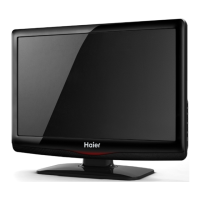
Do you have a question about the Haier L22C360 and is the answer not in the manual?
Adherence to regulations and warnings for service personnel safety.
Preventing electric shock and fire hazards during servicing.
Techniques to prevent damage from static electricity to components.
Using lead-free solder for environmental compliance.
Guidance on using specified replacement parts for safety and performance.
Post-repair checks to ensure safety and proper installation of parts.
Key precautions for safe and effective servicing procedures.
Information required for ordering replacement parts.
Note on illustrations and photos in the manual possibly differing from final design.
Explanation of icons used to draw attention to specific information.
Visual identification of main circuit boards within the TV.
Detailed view and description of the Main and AV boards.
Function of the main board in processing signals for display.
Pin assignments and signal names for main board connectors.
Pin assignments and signal names for the remote control connector.
Pin assignments for the keypad connector.
Pin assignments for the speaker connector.
Description of the power board's function to supply power.
Procedure for removing the TV pedestal.
Procedure for removing the rear back cover of the TV.
Procedure for removing the terminal bracket.
Procedure for removing the power module from the TV.
Procedure for disconnecting and removing the main board.
Procedure for removing the speaker from the TV.
Procedure for removing the remote control board.
Connecting external devices like antennas and accessories.
Connecting AV and YPbPr equipment to the TV.
Connecting the TV to a computer via VGA or HDMI.
Details for connecting devices via HDMI and HDMI-to-DVI.
How to connect DVD players or set-top boxes via HDMI.
Connecting devices via HDMI-to-DVI cable with audio connection.
Illustrations of HDMI, HDMI-to-DVI, and analog audio cables.
Instructions for connecting the TV to the AC power source safely.
Description and function of the TV's front panel buttons.
Identification of terminals on the TV's back panel.
Instructions for setting up and using the remote control.
System block diagram showing major components and signal flow.
Detailed circuit diagrams for the TV's electronic components.
Navigating and using the TV's channel menu for tuning and editing.
Adjusting picture settings like contrast and brightness.
Adjusting audio settings such as treble, bass, and balance.
Setting the clock, timers, and sleep functions.
Configuring OSD language and restoring factory defaults.
Accessing applications and media playback via USB.
Selecting and playing media files from USB devices.
Step-by-step guide for updating the TV firmware using a USB drive.
Accessing and navigating the TV's factory setting menu.
Basic troubleshooting steps for common picture and audio issues.
Diagnostic flowchart for identifying main board failures, focusing on sound issues.
Troubleshooting steps for diagnosing and resolving black screen issues.
Troubleshooting steps for diagnosing and resolving white screen issues.
Troubleshooting steps for abnormal panel display issues.
Troubleshooting steps for diagnosing and resolving no sound issues.
Troubleshooting steps for general TV channel reception failures.
Troubleshooting HDMI input issues related to picture display.
Troubleshooting PC input issues for picture display.
Troubleshooting picture issues for YPBPR, AV, and SCART inputs.
Vertical bars on screen due to TCP cracking or panel failure.
Gray lines on screen due to TCP sunken or mis-alignment.
Vertical color lines indicating panel or TCP failure.
Horizontal bars due to chip cracking or ACF bonding issues.
Horizontal gray lines related to TCP sunken or environment.
Horizontal lines indicating mis-alignment or panel failure.
Bright or dark dots on the panel, indicating incoming inspection issues.
Bladders in the polarizer layer of the panel.
Scratches on the polarizer layer of the panel.
Foreign particles or defects inside the polarizer.
General abnormal display issues like chip lose or connection problems.
Bright and dark display alternating, indicating circuit or connection issues.
White screen display with normal backlight, possibly due to surge current.
Black screen display with normal backlight, possibly due to surge current.
Flickering or crosstalk due to LCD Vcom imbalance.
Abnormal color due to capacitance issues causing crosstalk.
Abnormal color due to chip, IC, or connection issues.
Noise from the backlight unit or mechanism during panel operation.
Connectric circles indicating issues between mechanism and panel.
Backlight failure due to bad connection between wire and electrode.
Dim backlight brightness due to bad connection between wire and electrode.
Backlight failure due to damaged wire.
No backlight due to an open wire.
Intermittent backlight shutdown due to shorting or high power consumption.
F/M issues within the backlight unit.
Brightness unevenness at the bottom of the LCM due to backlight unit badness.
Asymmetric backlight brightness due to uneven sheet in the backlight unit.
Issues related to missing or damaged mounting screws.
